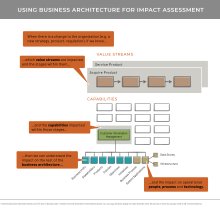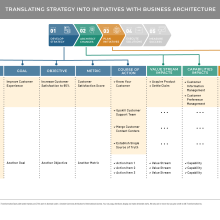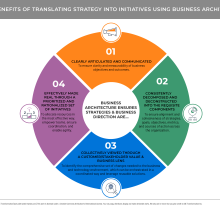Translating strategy and other business direction into an executable set of initiatives is one of the most important – and potentially challenging – responsibilities of business architects. This installment of StraightTalk breaks down what that actually means and how business architects do it (of course working hand-in-hand with business leaders, strategists and others). In doing so, we will weave together other important StraightTalks to help put the pieces together.
Here goes.
What is strategy?
Let’s think about strategy from the perspective of strategy guru Michael Porter, who defines strategy as competitive position: “deliberately choosing a different set of activities to deliver a unique mix of value.” He also indicates that the “essence of strategy is choosing to perform activities differently than rivals do.”1 Strategy is about choice.
The BIZBOK® Guide refers to the definition of strategy as “The pattern or plan that integrates an organization’s major goals, policies, and action sequences into a cohesive whole.”
BTW, while we are discussing translating strategy here, the same process applies to translating any type of business direction, whether a business transformation, a comprehensive set of regulatory changes, a joint venture, integration after a merger or acquisition, and so forth.
Where do we start to decompose and translate strategy?
Break the strategy down into components. There’s a sort of golden thread here that is simple but powerful in how it decomposes and deconstructs a strategy into just the right pieces and just the right detail.
These components include goals (often more abstract aspirations), objectives (quantitative, measurable results that define strategy), metrics (used to measure the objectives), and courses of action (a selected option to carry out a strategy). (P.S. See the Translating Strategy Into Initiatives With Business Architecture diagram later in this installment for example content.)
The BIZBOK® Guide appropriately emphasizes the importance of boiling down strategy to a measurable objective(s), which can be associated to applicable value streams and capabilities (more on this later). In addition, a defined course of action(s) is also critical for organizational alignment. For example, if an organization has an objective related to increasing revenue, achieving it by creating a new product versus offering existing products in a new market versus doing an acquisition are all very different courses of action.
While there are many finer points, here are just a few considerations:
- You may need to decompose components. For example, an objective can break down into more detailed objectives.
- You may have a many-to-many relationship between components. For example, a strategy may have multiple goals, or a course of action may apply to multiple objectives.
- You may not have all the pieces of information you need up front. Just capture what you have and keep working on the rest.
- You may uncover misalignment. For example, you may find that the collection of planned objectives will not fully enable a strategy. Or, you may find that business leaders are planning conflicting courses of action to meet an objective. Share your observations.
What if my organization categorizes information differently?
Different organizations and methodologies vary in the way that they categorize information within the components above. For example, an organization might only define measurable objectives, but not any higher level, abstract goals. Or, an organization might not call them goals, but they define a few key strategic priorities at an enterprise level which serve as aspirational statements. Or, an organization might define objectives without concrete measurements, but rather couple them with a metric and defined target value instead.
From a business architecture perspective, we’re not asserting a specific methodology or approach. The key is for an organization to have unambiguous and agreed upon definitions of each component – and for information to be categorized consistently within each. This might sound simple, but we know it is easier said than done. However, the promise is true clarity and alignment across an organization.
Where do techniques such as OKRs and balanced scorecard fit?
Objectives and Key Results (OKRs) is a goal-setting framework used by some organizations for defining and tracking objectives and their outcomes. In the paradigm described earlier, OKR objectives would likely equate to goals and OKR key results would likely equate to objectives. Again, what’s most important is that you decide how you are going to define each component of your organization’s golden thread and just be consistent.
In the paradigm described earlier, the balanced scorecard technique would likely equate to goals (though the Norton Kaplan strategy map technique calls them objectives) and metrics. Again, you define your golden thread and just be consistent.
What comes next after we have clear objectives and courses of action?
Not initiatives. That’s the classic behavior that leads to challenges such as the creation of redundant, conflicting and fragmented solutions, ultimately creating a poor customer experience and decreasing organizational agility. (P.S. See more on these challenges and the full strategy execution story in Posts No. 3, No. 50 and No. 72.)
What comes next is business architecture impacts, specifically value streams and capabilities.
Value streams provide the context for the impacted capabilities, and the capabilities are of course the rosetta stone that connect to the rest of the business architecture domains (e.g., business units, information, products, stakeholders, policies, and other strategies and initiatives) and the operating model including people, process and technology.
Instant impact analysis via the business architecture knowledgebase.
The handy diagram below represents the thought process:
It is very important to note that business architecture value streams and capabilities rarely "change" unless an organization's business model is changing, but rather they frame and coordinate where changes are necessary to people, process and technology. So, by indicating that a capability is “impacted” by a course of action, it really signifies that there are changes happening there, and the capability helps us to coordinate those changes.
BTW, as you start to identify the value streams and capabilities impacted, the importance of well-defined objectives and courses of action will become clear. Take your best shot at interpretation and then iterate with your leaders and/or strategy team as needed.
Where do business models come in?
As an organization evolves and innovates its business model(s), there can be impacts to business architecture value streams, capabilities and other domains. Assessing these impacts should feed into the step described above – and of course if there are concrete objectives or other directional components to be defined, it’s back to your golden thread. (P.S. See Post No. 80 for more on business models and how they fit with business architecture.)
How do business architects work with business leaders and strategists on all of this?
Partnership is the watchword.
First, work with your business leaders and/or strategy team to walk through the strategic direction so you can gain a better understanding. Next, take a first pass at defining the goals, objectives, metrics, courses of action and impacted business architecture value streams and capabilities, even if you have to make assumptions or fill in some gaps. Then, review your interpretation with the leaders/strategy team, identify changes needed, and iterate with them.
Leverage business architecture and your role as a consultative business architect to provide new insights and enable leaders to think differently and achieve their goals. By working together in partnership and taking initiative, you can minimize the time you require from your busy leaders and strategy team.
How do we come up with initiatives?
Initiative planning is the last step. Now that we have the areas of change narrowed down by impacted value streams and capabilities, we need to define what actually needs to change. For example, if the Customer Preference Management capability is impacted within the Initiate Interest stage of the Acquire Product value stream, is it a new capability? Or is a related process changing? Or is new automation being created?
Capability assessments can be very helpful input to determine what changes need to be made, because they provide concrete data around the importance and effectiveness of each capability. (See Post No. 28 for more on business architecture assessments.)
Once you have your arms around the changes that need to be made, you can organize them into a logical, coordinated and sequenced set of initiatives – each scoped and framed by the value streams and capabilities which they are uplifting. (See Post No. 71 for more on business architecture and initiative planning.)
An initiative in the BIZBOK® Guide is defined as “a course of action that is being executed or has been selected for execution” and does not delineate between methodology (e.g., waterfall or agile) or size (e.g., program, project, sprint). Regardless of how the work is being executed, business architecture helps to ensure that teams:
- Understand the business direction and how they fit within bigger picture
- Identify key collaboration points with other teams
- Coordinate on reusable business components and solutions
The diagram below shows the entire traceability from business direction to business architecture impacts to initiatives:
What if the strategy is not clear or detailed?
This is frequently a challenge in organizations, and it leaves a big gap between the defined high-level strategic direction and a cohesive understanding of what actually needs to change in the business and technology environment. The best way to work through it is just by doing the hard work of defining goals, objectives, metrics, courses of action and the impacted value streams and capabilities. The process of trying to define the pieces will illuminate gaps and missing detail that can be then be added.
And, over time this translation process provides feedback to the direction-setters, highlighting gaps and opportunities to enhance the strategy formulation and communication approach going forward.
See Post No. 31 for more on how to handle challenges with bad strategy, non-strategy and no strategy.
Why is it so important to translate strategy using business architecture?
Here are four benefits of translating strategy into initiatives with business architecture. Business architecture ensures that strategies and other business direction are…
- Clearly articulated and communicated – To ensure clarity and measurability of business objectives and outcomes.
- Consistently decomposed and deconstructed into the requisite components – To ensure alignment and cohesiveness of strategies, goals, objectives, metrics, and courses of action across the organization.
- Collectively viewed through a customer/stakeholder value and business lens – To identify the comprehensive set of changes needed to the business and technology environment, which can be orchestrated in a coordinated way and leverage reusable solutions.
- Effectively made real through a prioritized and rationalized set of initiatives – To allocate resources in the most effective way, empower teams, ensure coordination, and enable agility.
The diagram below represents these four benefits:
And that’s it, you’re translating strategy into action with business architecture! It’s easier said than done, but you can work through a lot of ambiguity, misalignment and politics by staying true to the simplicity of this method and its principles.
More Good Stuff...
What Is Strategy? (Michael Porter in HBR): This one is just classic.
Architect Your Company For Agility (MIT Sloan by Jeanne Ross): Pure gold. This will help you make a case for business and enterprise architecture. “…a great strategy is valuable only if a company is capable of executing that strategy. And whether or not a company can execute its strategy depends largely on whether it is designed to do so. In other words, it depends on business architecture – the way a company’s people, processes, systems, and data interact to deliver goods and services to customers.”
Strategy Under Uncertainty (McKinsey): A 2000 classic that is still highly relevant.
The Perils of Bad Strategy (McKinsey): An article on bad strategy and its root causes—as well as hallmarks of good strategy.
Why Strategy Execution Unravels—and What to Do About It (HBR): A video that articulates the five myths of strategy. Business architecture can help with every single one.
20 Reasons Why Strategy Execution Fails (Forbes): A nice list of strategy execution problems to tackle. P.S. business architecture can help.
Strategy Safari: Complete Guide Through the Wilds of Strategic Management (book by Mintzberg, Ahlstrand and Lampel): An outstanding review of the major schools of strategic management thinking.
The Strategy Execution Metanoia (S2E): If you haven’t read it, check out this white paper which explores a new vision for strategy execution and describes business architecture’s role throughout.
Leveraging Business Architecture: Translate Strategy into Action (Kuehn for Cutter Consortium): An on-demand webinar describing the role of business architecture in translating strategy into action.
Part 1, Sections 2.1 and 3.11, and Appendix B.1 of BIZBOK® Guide (Business Architecture Guild® membership required): For more on strategy mapping and the role of business architecture in strategy execution.
How Language Shapes the Way We Think (TED Talk): A TED Talk by Lera Boroditsky that will make you marvel at language and how it shapes our worlds. What thoughts do you wish to create?
- 1From: “What is Strategy?,” a classic by Michael Porter found at: https://hbr.org/1996/11/what-is-strategy



